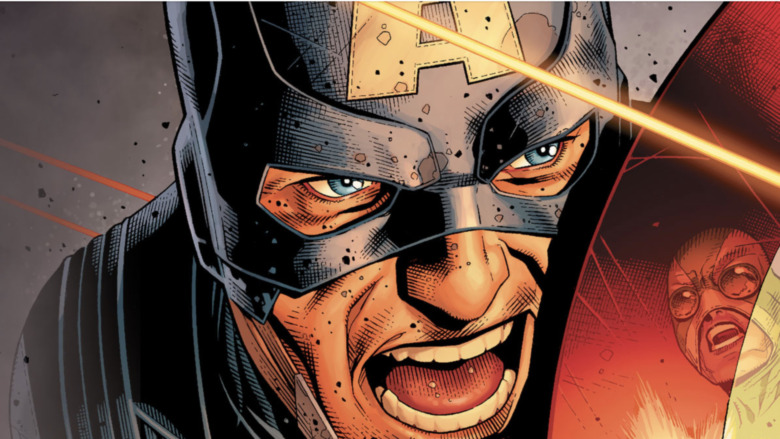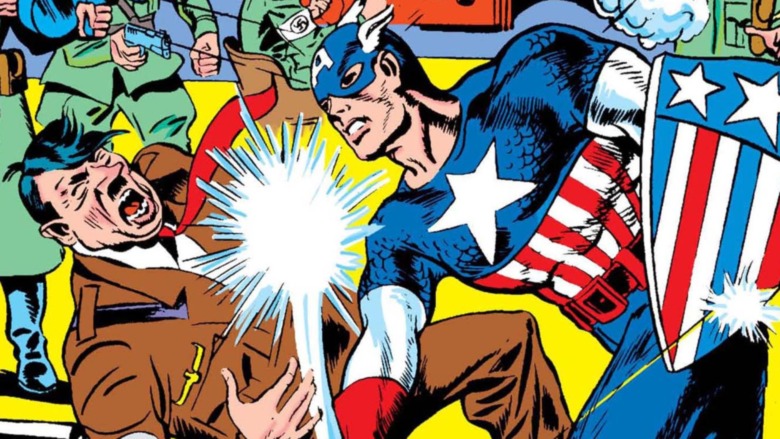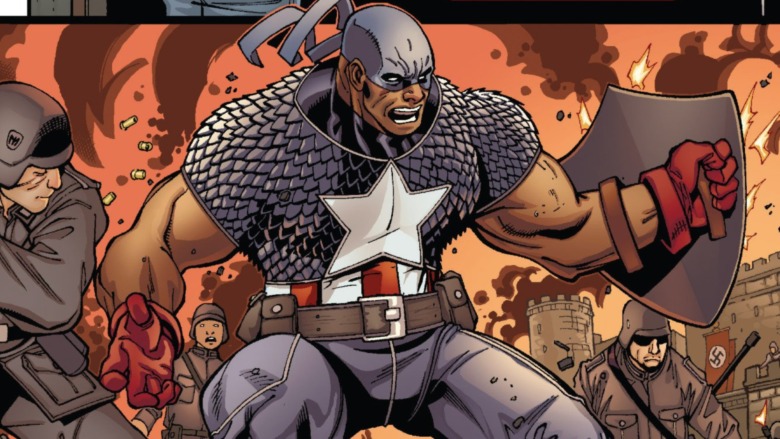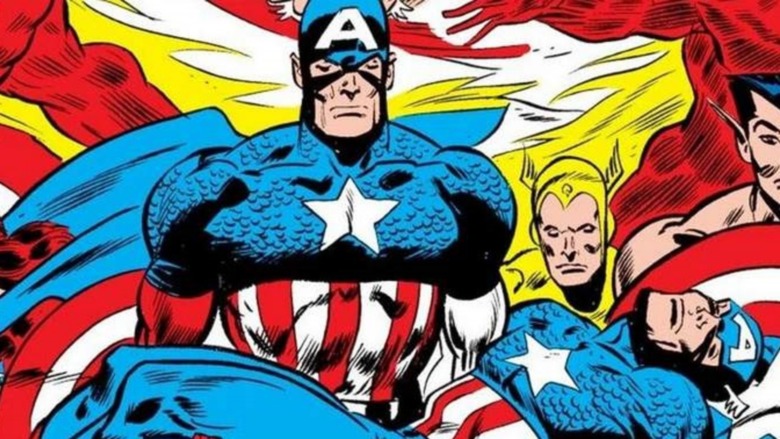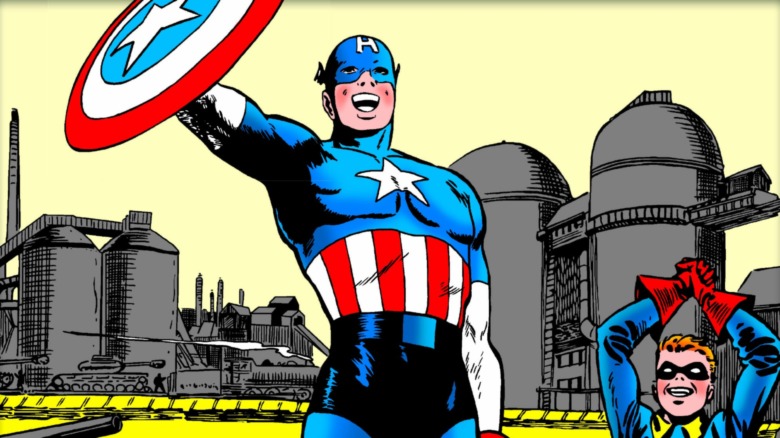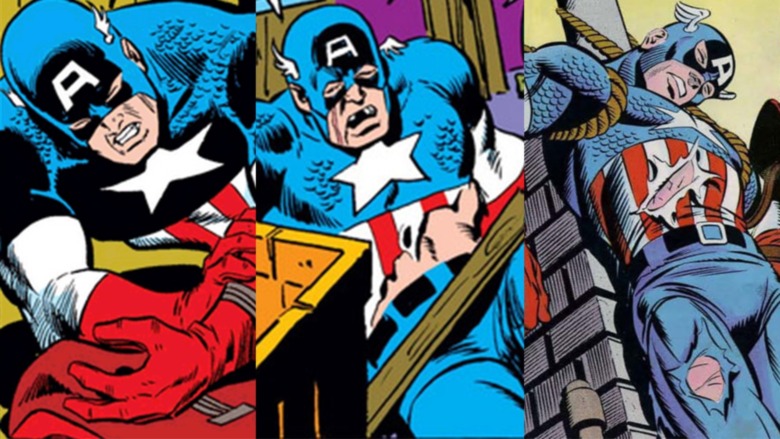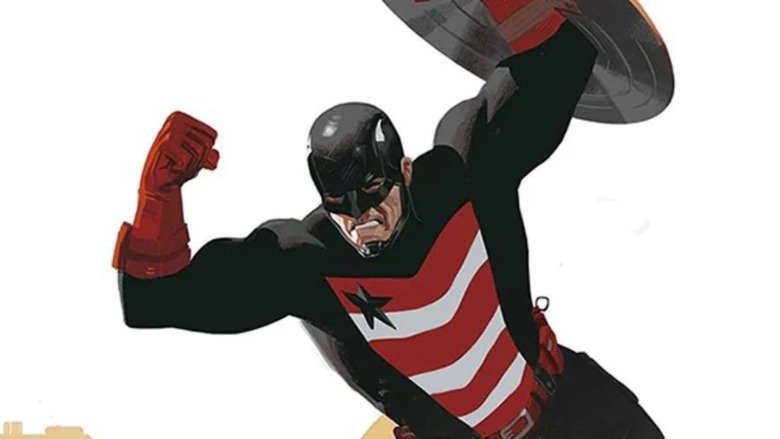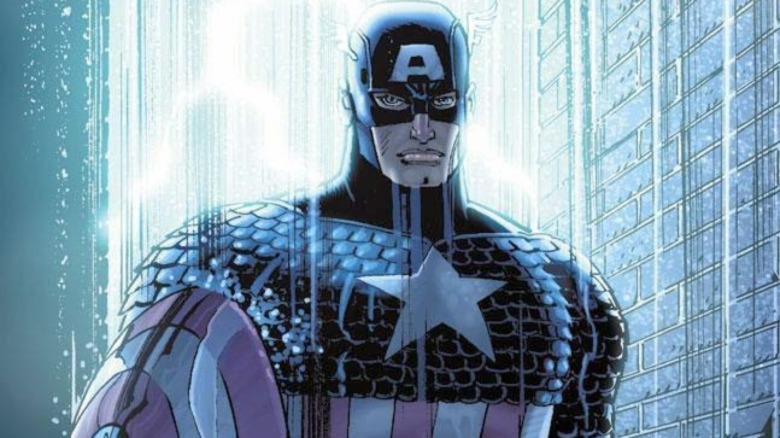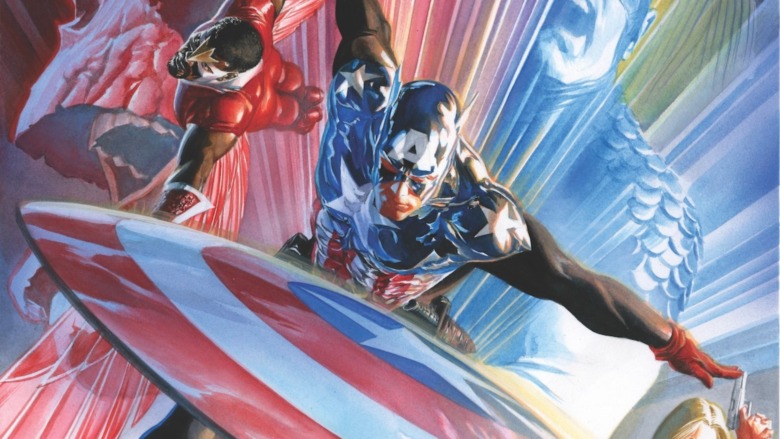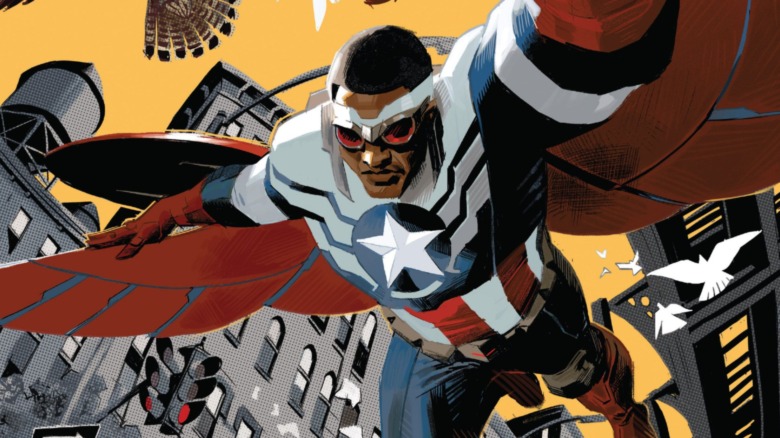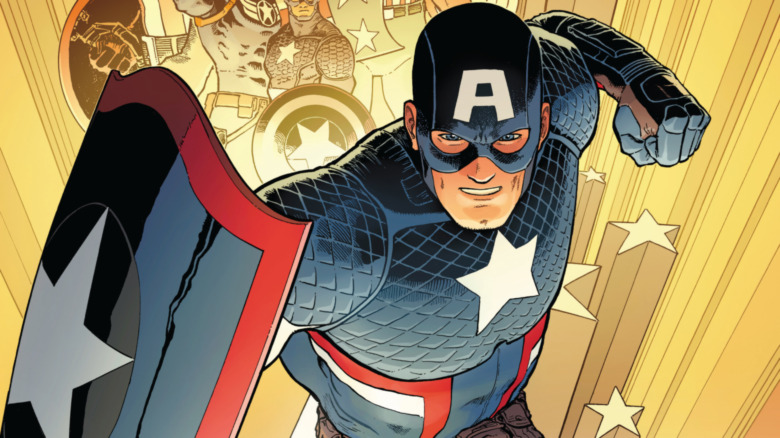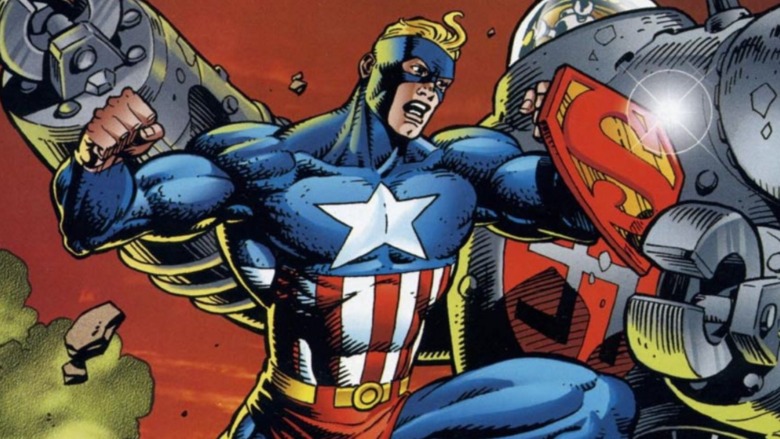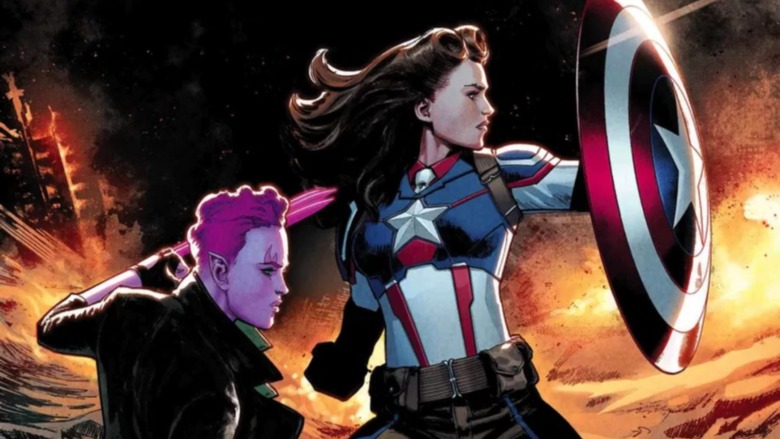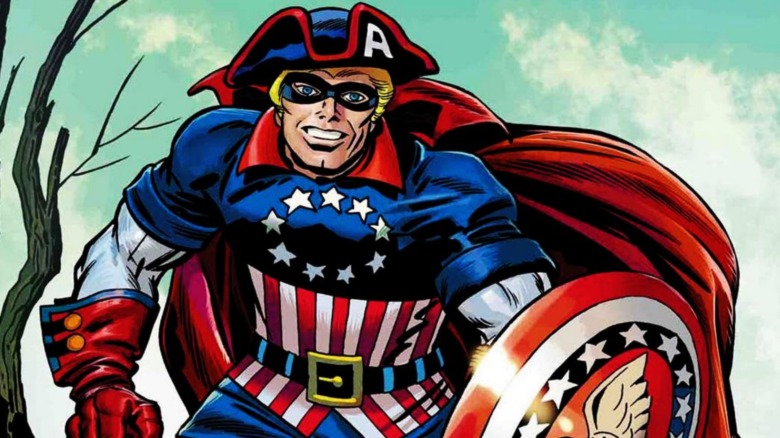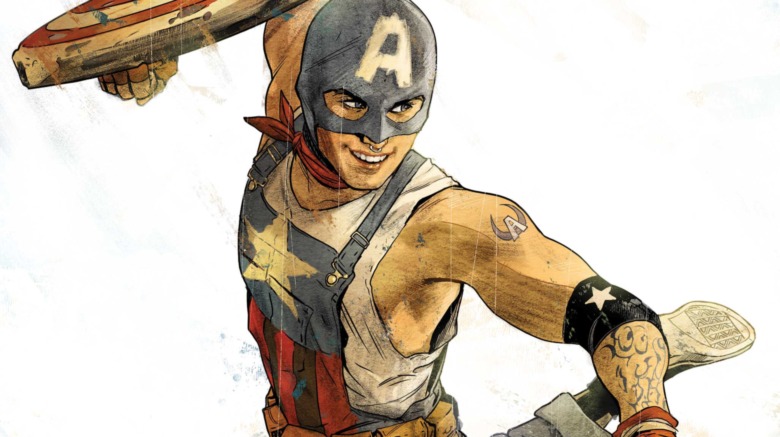The Many Captain Americas Of Marvel
For a decade, fans of the Marvel Cinematic Universe had only seen one man as the superhuman patriot known as Captain America — but that all changed following the events of Avengers: Endgame. After Steve traveled into the past, lived out his life, and returned to the present the long way round as an old man, he passed his shield on to his friend Sam Wilson, the Falcon.
But the legacy of Captain America did not end there. Many expected Sam to adopt the red white and blue, but the Disney+ series The Falcon and the Winter Soldier has now introduced audiences to a brand-new Captain America, a man of dubious motives (and anger management issues) named John Walker.
To long-time readers of Marvel Comics, however, this changing of the guard has been old hat for decades. Marvel has a long and storied history of other characters picking up Cap's famous shield when he could not or would not do so himself. Add to this the altered timelines and alternate reality versions of the hero, and...well, just read on to learn about some of the many, many Captain Americas of Marvel Comics.
Steve Rogers, the First Avenger
The one, the only, the original Captain America.
Anyone reading this likely already knows exactly who he is and how his story unfolds. Too small and weak to join the army, Steve Rogers joined the Super Soldier Program in order to serve his country during World War II. Injected with Dr. Erskine's famous serum, the scrawny boy was suddenly transformed into the absolute peak of human ability. Steve joined the war against the Nazis, often battling the Red Skull and Hydra.
Near the war's end, however, Steve was plunged into the arctic sea while stopping a bombing run, but the super soldier serum kept him alive, causing him to spend decades frozen beneath the ice. Years later, Steve was eventually found and reanimated in Avengers #4 (published in 1963), joining the newly-formed team in their efforts to protect a world he no longer recognized.
Though it might seem strange to bother including Steve Rogers on a list like this, it's important to note the original, especially since the origin of nearly every other Captain America listed here begins with a need to attempt to replace Steve for one reason or another. He is the standard by which every other shield-bearer is judged, and no list would be complete without the OG.
Isaiah Bradley, the Hidden Hero
The second person to become Captain America wasn't replacing Steve Rogers but was rather the tragic victim of a horrific attempt to replace the Super Soldier Serum formula lost with Dr. Erskine's death. Truth: Red, White & Black #1-7 (published in 2003) explores the United States government's attempt to try to reconstruct the serum through trial and error at the cost of human lives.
In an eerie reference to the horrific Tuskegee Experiments, the United States enlisted Dr. Wilfred Nagel to experiment on 300 African-American soldiers in order to slowly reconstruct the lost Super Soldier Serum. When all was said and done, only five had survived and were successfully enhanced.
Of those five, only Isaiah Bradley lasted long enough to be sent on a suicide mission to destroy the Nazi equivalent of the Super Soldier Program. Isaiah stole a Captain America uniform and shield meant for Steve Rogers and successfully completed the mission — but was arrested, imprisoned, and experimented on once again upon his return to the states.
Played by Carl Lumbly in The Falcon and the Winter Soldier show, many fans met Isaiah for the first time when Bucky and Sam tracked him down in Baltimore in the show's second episode. Audiences also met his grandson Elijah, who in the comics became the super-hero known as "Patriot" after a blood transfusion from his grandfather made him a super-soldier.
The Original Replacements
When Steve Rogers disappeared within a block of ice in the arctic ocean, the US Government could only assume that he had died. Seeking to avoid the disastrous impact on morale that Steve's death would undoubtedly have, the POTUS decided to keep this information a secret and instead appointed two official replacements of Captain America.
The first, a man named William Nasland, had already been active as a superhero named "Spirit of '76" before receiving the offer to become Captain America in Invaders #14 (published in 1977). William accepted, and though he was not injected with the Super Soldier Serum, he was given a replica of Rogers' famous shield made out of normal, destructible steel. He was sent to the front alongside the Invaders, a WWII-era team of superheroes, and was eventually killed in combat.
For the same reasons as before, the president chose yet another man to take up the shield in a series titled Captain America: Patriot (published in 2010). The government picked another existing superhero, this one named Jeffrey Mace and operating under the name "Patriot." Though similarly under-powered and under-armed, Mace managed to survive the end of World War II and retired from the Captain America ranks in the year 1950, as he believed the hero was no longer needed.
William Burnside, the Tragic Experiment
Sadly, Isaiah Bradley wasn't the only man whose life was ruined in an attempt to replicate the Super Soldier Serum. When Stan Lee decided to incorporate Steve Rogers into his growing Marvel Universe, his 1945 exit for the hero conflicted with Captain America's continued appearances in comic books well into the fifties.
Though initially ignored, Steve Englehart introduced the idea that the 1950s Captain America was yet another attempt to recreate the serum and create a new patriotic super soldier. Reintroduced in Captain America #153 (published in 1972), fans met historian William Burnside, who was obsessed with Rogers and discovered a copy of Erskine's secret formula, offering to give it to the US government if they allowed him to fight in the Korean War as the new Captain America.
The government agreed, and so Burnside changed his name, face, and voice to exactly match Steve Rogers. But before the serum could be administered, the Korean War ended and the United States lost interest entirely.
Undeterred, this new "Steve Rogers" took the formula anyway and soon defeated a communist Red Skull. The formula was flawed however, and though it gave him greater strength than his idol, it also affected his mind, causing him to lose his sanity. The US put Burnside in stasis until a cure could be found, and he was eventually released from his ageless prison in present day, where he fought the real Steve Rogers for the mantle of Captain America.
The Nomadic Replacements
Thawed in the present day, Steve continued to serve his country proudly alongside the Avengers as Captain America. Over time, however, he grew disillusioned with increasing corruption in the United States government and denounced his former mantle and shield, becoming a new hero known as Nomad instead. During this time, three different men all tried and failed to take up the mantle, and one of them paid for their failure with their life.
In Captain America #178 (published in 1974), star baseball player Robert Russo tried first but quickly gave up after misjudging a swing over a wall and breaking his arm. In the next issue, street tough Scar Turpin gave it a shot, and after receiving an extensive beating while trying to stop a mugging, he never tried again. Neither men were trusted with Steve Rogers' indestructible shield.
The final replacement was a man named Roscoe Simons. After the two previous failures, Roscoe decided to try, proving himself capable enough in battle to be trusted with Rogers' actual shield and even began training under Sam Wilson, the Falcon. His heroics were ultimately short-lived, however. In his first encounter with the Red Skull in Captain America #183, the villain immediately knew Roscoe was not the true Captain America and killed him, prompting Steve to once again step forward.
John Walker, USAgent
When Steve Rogers retired as Captain America yet again, a new, much more successful replacement was chosen to take on the mantle in Captain America #333 (published in 1987 with a classic "Who will be the next Captain America?" cover). US Army veteran John Walker was just a normal man before he was given powers equivalent to the Super Soldier Serum by the Power Broker. Though initially operating as "Super-Patriot," he welcomed the opportunity to become the new Captain America and filled the role with gusto.
Handed Cap's indestructible shield, Walker was by far the most physically capable and successful replacement up to this point, but his hardline stances and merciless execution of his interpretation of the law made him a far darker Captain America than Steve had ever been. After he viciously tortured and murdered a group of criminals who had killed his parents, Steve decided that Walker was too unstable to keep the role any longer and stripped him of the shield and title in 1989's Captain America #351.
Of course, John Walker joined The Falcon and Winter Soldier recently as the Marvel Cinematic Universe's first replacement Captain America. Viewers will have to watch and see if he proves worthy of the role, or if his dark tendencies that follow his comic book origins prove to be Walker's downfall.
Clint Barton, the Captain Who Refused
When Steve Rogers was assassinated in 2007's Captain America #25 at the end of the comic book version of Civil War, Tony Stark tried desperately to find someone who could fill the void Steve left behind. In Fallen Son: The Death of Captain America #3, Tony revealed that his first choice was none other than Clint Barton, the heroic marksman better known as Hawkeye. Though a seemingly odd choice at first glance, Iron Man eventually revealed that he chose Clint because he was one of the only other people on the planet who could actually handle Cap's indestructible shield.
Though reluctant at first, Clint went out for one mission as the new Captain America in honor of Steve's memory, but even though he performed perfectly and handled the shield with ease, that was the last time he ever did so. Iron Man had sent Barton on a mission to capture other heroes from Steve's side of the Civil War, and once Barton realized this, he immediately turned on Iron Man and used the shield to distract Tony long enough for himself and the other heroes to successfully escape.
Bucky Barnes, the Original Heir
Tony eventually found Steve's replacement in the last place he wanted to look: Captain America's original partner, Bucky Barnes, the Winter Soldier. Made famous by the movie of the same name, Bucky's journey from World War II sidekick to secret Russian super-assassin is well established — and just like in the movies, Steve helped him reject his brainwashing and recapture his inner heroism.
After Steve's death, Bucky had no desire to become the new Captain America, but after the increased insistence of many of his closest friends and allies, he finally took up the mantle in Captain America #35. Bucky initially used a gun, but eventually grew comfortable enough with the shield and identity to fight evil without it.
As the new Captain America, Bucky defeated William Burnside's second attempt to claim the title for himself and also fought against Norman Osborn's "Dark Avengers" team. When Steve Rogers eventually returned to life a few years later, Bucky gave his old friend back the shield and then adopted the identity of the Winter Soldier once again.
Sam Wilson, the Heir Apparent
The star of the Disney+ hit television series, Sam Wilson (played by Anthony Mackie in the MCU) is better known as the super-heroic Falcon. A social worker in New York, Sam befriended Steve after he was freed from the ice and eventually became his partner in crimefighting starting with Captain America #117 (published in 1969).
Sam remained Steve's staunch ally for years and became so popular that Captain America's solo comic book series was renamed Captain America and the Falcon with issue #134. Sam eventually joined the Avengers and fought alongside his friend all over the world.
Later, Steve Rogers was stripped of the Super Soldier Serum that gave him his strength in 2014's Captain America #21 and subsequently transformed into the scrawny weakling he had been in his youth. Rogers asked Sam Wilson to take up the Captain America mantle in his stead, and though reluctant at first, he ultimately accepted, becoming the All-New Captain America in issue #25. Adopting a costume that kept the wings of his Falcon days, Sam took to the skies to use his shield to battle evil and various social injustices across the country.
Does the MCU hold a similar path forward for Mackie's live action Falcon? Only time will tell.
The Nazi Imposter
When Steve Rogers was seemingly returned to normal, he insisted that Sam Wilson keep the shield, and the two both remained Captain America at the same time. In 2016's Steve Rogers: Captain America #1 however, Rogers was revealed to be a secret agent for none other than Hydra, the very evil that he had fought for almost his entire life.
"Steve" schemed for months, manipulating Sam until he was so disillusioned that he gave up being Captain America on his own. When he was finally ready, he led Hydra to victory and conquered the entire country in the event known as Secret Empire.
Thankfully, his time in power proved short-lived. Sam Wilson, upon realizing what Steve had become, joined the underground resistance, took back the shield, and became Captain America once again. The heroes eventually discovered that Hydra's "Steve" was from an alternate timeline and managed to recover the true Steve Rogers once and for all, who defeated the Hydra imposter.
After the dust settled, Sam Wilson retired from the role of Captain America for good — returning the shield to the real Steve so that he could begin regaining the nation's trust.
Clark Kent, the Super Soldier
Though many heroes from Marvel Comic's vast catalogue of characters have donned the shield and mantle of Captain America, the most unexpected person to do so didn't belong to Marvel at all — because it was Superman.
In 1996, DC and Marvel Comics agreed to one of their rare, official crossover events in a series titled Marvel versus DC. The miniseries was predicated on the gimmick that fans would vote to decide various match-ups (Superman vs the Hulk, for example), essentially determining the plotlines.
Though this led to some rather questionable victories, the series eventually saw the two companies' heroes temporarily merged into an Amalgam Universe in Marvel versus DC #3 featuring mashups like Dr. StrangeFate (Dr. Strange and Dr. Fate), Dark Claw (Batman and Wolverine), and Super Soldier (Superman and Captain America).
Still named Clark Kent, Super Soldier gained the powers of Superman in the 1940s when he received a super soldier serum developed from the cells of a deceased alien corpse. With his newfound strength, Super-Soldier took the fight to the Nazis and frequently battled with Lex Luthor, the leader of Hydra.
Peggy Carter, the Super-Spy
Before he became trapped in ice, Steve Rogers was in love with a woman named Peggy Carter (played on screen in the MCU by Hayley Atwell). A British secret agent, she was involved in the Allies Super Soldier program alongside Dr. Erskine and worked with Steve in Europe once he became Captain America. When Steve woke up in the modern world, however, he found that Peggy was now an old woman and their romance was one of the many casualties of his lost decades.
In one alternate reality, however, things didn't follow the same blueprint. 2018's Exiles #3 revealed a new reality titled Earth-86315 where the assassin that killed Dr. Erskine also killed Steve Rogers before he could take the serum. Encouraged by Howard Stark, Peggy Carter took the Super Soldier Serum and became Captain America herself. Combined with excellent combat and espionage skills from her time as a spy, her new superhuman abilities were put to devastating use against the Axis Powers.
Steven Rogers, the Colonial Patriot
One of the most bizarre alternate Captain Americas is technically canon to the main Marvel Universe. Created by Jack Kirby in 1976's Captain America #194 and Captain America's Bicentennial Battles #1, Steven Rogers was a captain in the American Revolutionary War who disguised himself in an outfit decorated like Betsy Ross' new flag. He fought alongside General George Washington until he was struck by a cannonball and finally killed in one of the final battles of the war.
Though some referred to him as "Captain America," his descendent Steve Rogers would eventually become the first individual to truly carry that title during World War II. Though the gargantuan coincidences needed to create this story stretch the suspension of disbelief to the breaking point, it's still a fun story that essentially functions as a "What If?" where Steve became Cap a century and a half before he traditionally does.
Aaron Fischer, the Captain America of the Railways
By far the most recent addition to this list is Aaron Fischer, the "Captain America of the Railways." Set to debut on June 2021 in United States of Captain America #1 by writer Christopher Cantwell and artist Dale Eaglesham, Aaron will be the first openly gay Captain America. The series' story will follow John Walker, Steve Rogers, Bucky Barnes, and Sam Wilson as they seek Steve's missing shield.
During their search, they will apparently come across different characters who have been impacted by the symbol of Captain America, one of whom will be Aaron Fischer. Promotional materials show Aaron wielding a home-made approximation of Cap's costume along with a trashcan lid painted like his famous shield. Although he does not possess any of the superhuman abilities of his idol, Aaron will be a force for good who helps runaways and homeless youth along the city's many railway lines.
